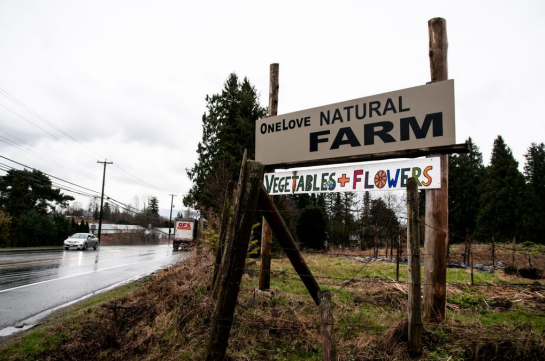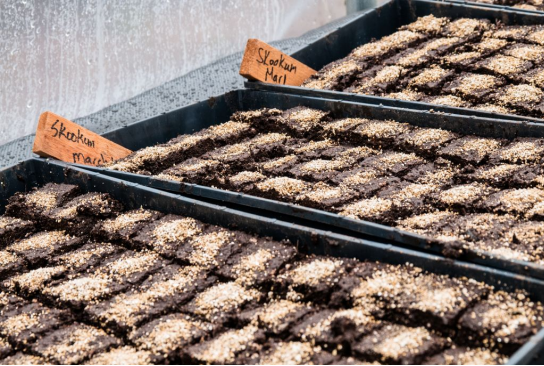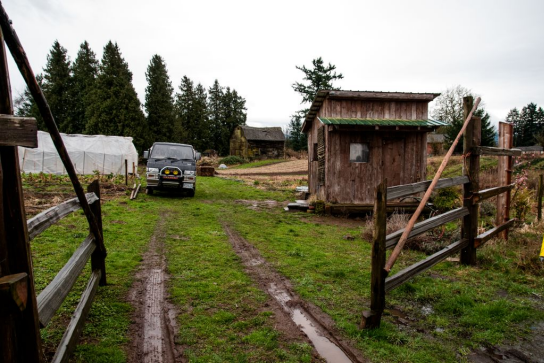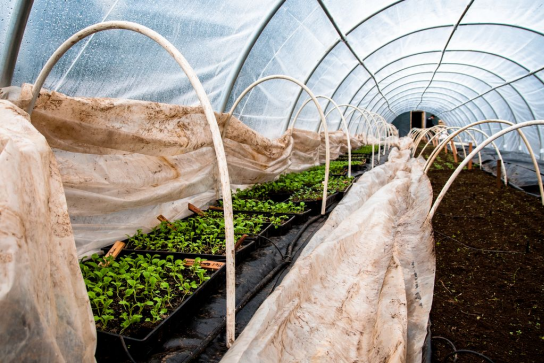By Sasha Moedt (The Cascade) – Email
Print Edition: March 6, 2013
One Love Farm
I arrive at the farm on a wet weekday morning. It’s only a few minutes drive into the countryside from UFV’s Abbotsford campus, but it feels like I’m in a completely different world. The wooden sign standing before me reads “One Love Natural Farm,” and beyond it stretches the farm, muddy and rugged in the steady grey rain.
The farmer, Chris, meets me as I wander down a path between rows of raised soil beds. “Welcome to One Love farm!” he says. The first thing I thought upon meeting Chris was that I couldn’t imagine him doing anything but organic farming. Rugged and serious-looking, with dreadlocks and a shy smile, he fits into the landscape.
“Things are waiting for spring right now, lots of little stuff coming up. The spinach I planted in August is starting to flesh out now,” he says, and gestures over to the raised beds with the recognizable green leaves growing nicely in their row. “I haven`t grown much on the coast at all, so it`s nice to know I can have chard right up to mid-January and kale pushes right on through.”
Chris originally lived in the BC interior. There he began growing in Lilloet and Anderson Lake before moving to the West Coast about 10 years ago. “I did a lot of colder winters there so there wasn’t much question about planted stuff over winter, so I’d just take the winters off.” But here Chris is pretty pleased with his chard and kale. “I get kale customer and chard customers all winter long, so I’m learning what grows well here in the winter.”
He started One Love a year-and-a-half ago, quitting his job and leasing the one-and-a-half acres.
We walk over to the shed where Chris shows us his walk-behind tractor. “Last year I didn’t have anything, I had a little rototiller I rented from Home Depot once a month maybe … It’s going to be a good year for One Love farm. I’m going to produce a lot.”
We move down the main path bedside the raised beds, where in the summer and spring, vegetables will grow and flourish. Some rows are covered with hay, others are bare.
“This is all my garlic,” he says. “That’s planted in October and harvested in August … These beds are for peas, leeks back there.”
The beds are laid out precisely where they should be and Chris has a map of it in his head. “It’s all planted – I know exactly where it is. I do the raised bed system. It makes sense to me to have your areas where you’re growing and your areas where you’re walking.”
Chris explains that with a raised bed system he can use other methods, instead of using a machine to constantly break up the soil. Once the weeds are under control, cultivating can be done using cover-crops and inter-planting, or just by hand. “Ultimately it would be nice to just keep that soil structure intact, disturb it as little as possible and just add nice compost every time you plant something.”
We pass the compost heap – Restaurant 62 on McCallum and Marshall buys One Love veggies and gives their compost back to fertilize soil for more veggies. We pass to the next field over. Holes are dotted on the ground.
“Voles, Chris explained. “They’re crazy! This is their active time, they should hopefully subside.”
Over on the next field is a long greenhouse – thick plastic sheeting pulled over arched metal bars to create a sturdy structure. Chris explains that he’ll be building another one, next time with wheels. “You can actually move it from season to season; it’ll be on a track, to cover different crops at different times.”
Inside the greenhouse, we stoop down as Chris proudly shows me “a smorgasbord of salad” – tomatoes, Italian chicory, wild arugula, radishes, lettuces, big globe artichokes, onions, you name it. Of course everything is small, tiny buds, but it’s easy to imagine the thick carpet of greens that will soon grow.
It’s a start—a vision—and Chris’s enthusiasm is infectious.
On Organic Farming
Being an organic farmer isn’t easy. There’s no cheating. But it is possible to support yourself, Chris explains.
“People are putting value on food again,” he says. “Otherwise it would be difficult to compete with Save-On and Costco. You can buy potatoes there for 50 cents a pound whereas in the summer I’m charging $2 a pound and that’s still cheaper than what you can get fresh potatoes for at the market. People are tuning in.”
Organic certification is a difficult process – especially for farmers just starting up. Chris tells us that to be officially organic—which he is not—you need money and lots of paperwork.
“I’m always organic no matter what, whether I have that piece of paper or not. Customers can come to the farm and they can see what’s going into into their food,” Chris says. “It’s one of those things where you don’t get yourself certified, you get that field certified.”
Chris initially leased the land for three years – but it takes a couple years to get certified, and he wasn’t sure if he could commit to putting the time and money into certifying a field that might not be his. But after a couple of successful seasons, Chris is extending his lease to 2019 – and becoming certified is something he’d consider.
“It’s something I believe is important; accountability should be there, and I believe in some sort of certification,” Chris says. “I’ll get there.”
Of course, as a farmer just starting up, you don’t have a ton of money, so it’s a hard thing to do. And it’s one thing on a long list.
“I’ve got to build the greenhouse,” he says. “Money goes into that first!”
The Methods
There’s one question that always comes to mind about organic farming: what do you do to make it work? I always imagine my plants withering away in the garden without a bit of Round-Up or slug bait.
Chris explains that there are three main things we use chemicals in farming for: feeding and warding off disease and insects. The feeding includes nourishing the soil and fertilization. The disease might be fungus, blight or weeds, and the insects might be something like wireworms.
Chris explains that he doesn’t necessarily look at plant nutrition as feeding. “I rarely have time to actually feed soluble nutrients – I do make compost teas. And my tomatoes, they’ll get some organic liquid nutrients at key times. But I strongly believe in health of the soil, so every time I plant something I put fresh compost on the soil. I’ve got mixed powders and minerals that go into the soils; I’m always giving back.”
Chris says it’s all about keeping a system healthy. “I try and deal with it as a holistic thing.”
This goes for all parts of growing plants. “You’re always going to have insects and bugs – but if you use something to kill all the one insects you don’t like, unfortunately you’re killing all these other insects that you do like, that are good.”
“So you lose a few carrots,” Chris says, “big deal, the whole is healthy.”
Chris explains that the most important thing is just this: keeping the balance, and making sure that all parts of the whole are healthy – especially the soil.
Another technique for encouraging healthy soil is cover crop. As we walk over a thick bed of clover, Chris explains the two main uses of cover crop: one is to stifle the weeds, the other is to add organic matter to the soil for erosion control.
“You don’t really want to leave bare soil for very long,” Chris says. “The sun and the rain is hard on bare dirt. Inter-planting can be cover crop too, where you’re basically using it as weed suppression in the bed.”
For example, Chris explains, wireweed sometimes gets in his potatoes. Wireweed doesn’t like mustard seed. “So basically when you plant the potatoes, you plant the mustard seed.You mow it in and hill the potatoes with it and it deters the wireworm.”
Soil is a living thing – there’s life in it.
“All these beds are thriving, happening support beds for these plants. You just plug in your seeds to this live thing and they will flourish for the most part. Except,” he says with a laugh, “when there’s [a] huge amount of wireworms and they’re really hungry and they want to eat all the roots of your onions, and you lose a big patch.”
But in this we see another important technique: diversity. Chris grows over 200 varieties of plants, and there is a very slim chance of everything being attacked by wireworms or otherwise. “Two or three things might be lost, but if I’m planting five different types of broccoli, one variety might be susceptible, but another might not be.”
Raising Generations
The way we grow plants has changed to satiate consumer wants. Plants are bred specifically for a certain quality—everything from size, colour and texture—and variations are being lost. This, Chris explains, is the difference between two kinds of growing: open pollination and hybridising.
Open pollination is essentially letting plants pollinate each other. “It’s naturalized, it’s a stabilized variety,” he says. The gene pool is varied, Chris explains.“So generally there are older varieties that are open pollinated and stabilized – basically what will happen is the plants can pollinate each other and then you have a seed that you can plant next year.”
On the other hand, hybridising plants means taking a couple of plants and breeding for a certain trait. This isn’t bad, of course, if you’re breeding for nutrition or taste,” Chris says. “But if you’re only planting hybrid seeds … if you’re growing only hybrid plants, you’re not allowing the gene pool, you’re just kind of stifling the gene pool.”
Chris explains that if everyone just stopped growing open pollinated, and just grew hybrids for a couple of seasons, we’d lose many varieties.
“We already have lost tons and tons of varieties because those varieties don’t get grown, they get cross-bred and then diluted out. That’s why it’s important to also grow open pollinated stuff. But hybrids have their place.”
Chris grows a few hybrid plants—customers, after all, expect things like nice big broccoli heads, and hybrid plants can provide these features—but he is well aware of the importance of open pollination.
Hybrid plants, being bred with only a few traits, cannot continue on healthily and have more seeds – but open pollination seeds can grow for generations and generations because of their biodiversity. These are called Heirloom or Heritage varieties. They have stories.
Chris is planting his own story: a purple fava bean that he grew in the Kootenays.
“I originally got the seed from West Coast seeds, but I probably grew it for 10 years straight and then I didn’t grow anything for eight years … and I just found, in my stuff, a purple fava bean. So I planted it this year. They’re a pretty solid bean, so it might sprout. So that would be my legacy, my bean legacy,” he laughs.
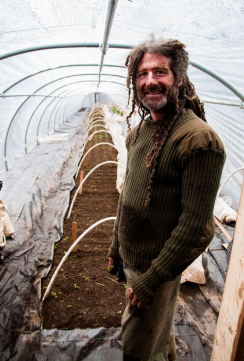 Invaluable Knowledge
Invaluable Knowledge
The plants taught me and the old-school magazines,” Chris laughs. He tells us that he’s no expert. “I know I’m learning everyday and trying new techniques because that’s the way I am.”
“But I’d have loved to have someone teach me and show me the ropes, learn from their mistakes,” he says. Michelle Rickaby, International Education program coordinator at UFV, was the first person who called Chris and set up a time to volunteer to work with him. “It was amazing. I knew she was coming, so I had these things set up for us to do, and we got them done. At the end of the day I felt like I got a lot accomplished. I felt that she took something from it – she’s a gardener, and she wanted to learn more about gardening as well. It was a great experience, and I’d love to make it happen more.”
Chris informs me that he’d be very willing have people come and help him and learn during the process. “I’m open to other people – they have different insights and observations. I’m fully open to it … For me I get everything I can accomplished, but I fall behind. If I could have someone – if I could have help sometimes that would be mutually beneficial, that would be wonderful. If I did have more help, we could make this place amazing.”
Chris considered having a volunteer day, where a group of people might come to learn about the farming process. Otherwise, a person who wanted a more intimate knowledge of the land might have an internship type of relationship. It would take time, Chris says. “Someone who really wants to learn farming, organic farming, that’s the only way you really learn – spending time with the plants.”
A Vision
One Love organic farm is young, but Chris has a vivid image of what the place might become. It would be his dream to have “a really functional, tight, a raised-bed farm.”
“The soil’s beautiful, and you just plug in your veggies,” he says. “Have a nice rotation happening of all the crops and have the nice companionship of plants growing all year round.”
A greenhouse is in the vision. He’d like a geodesic dome greenhouse, with wind or solar powered lights so he could do his starts—the first step in growing a crop—there. Currently, he does his starts at his home in Abbotsford. Chris would want a workshop area in the greenhouse perhaps as a place for people to learn.
That’s the big picture – but for the next couple years, Chris is going to focus on having that functional, healthy farm, with everything under cultivation and everything in a cycle.
“My corn this year, I’m going to plant the nasturtiums all along it, ‘cause I love nasturtiums, the flowers are great and they’re a great insect deterrents,” Chris describes enthusiastically, “so [for] my whole corn patch, just the edges are going to be soft with these nice mounds of nasturtiums.”
“I just want this place to be visually stunning, a paradise of wonderful, most beautiful vegetables you can find anywhere. That’s what my vision is.”
The going is slow right now, but as we move into the spring season, things are going to become alive at One Love. Come May, the vegetable stand will open, from 3 to 7 p.m. on Fridays and 9 a.m. to 1 p.m. on Saturdays.
As an incentive for UFV students, Chris says that they would enjoy a 10 per cent discount, so be sure to take your student card along for your next visit.

